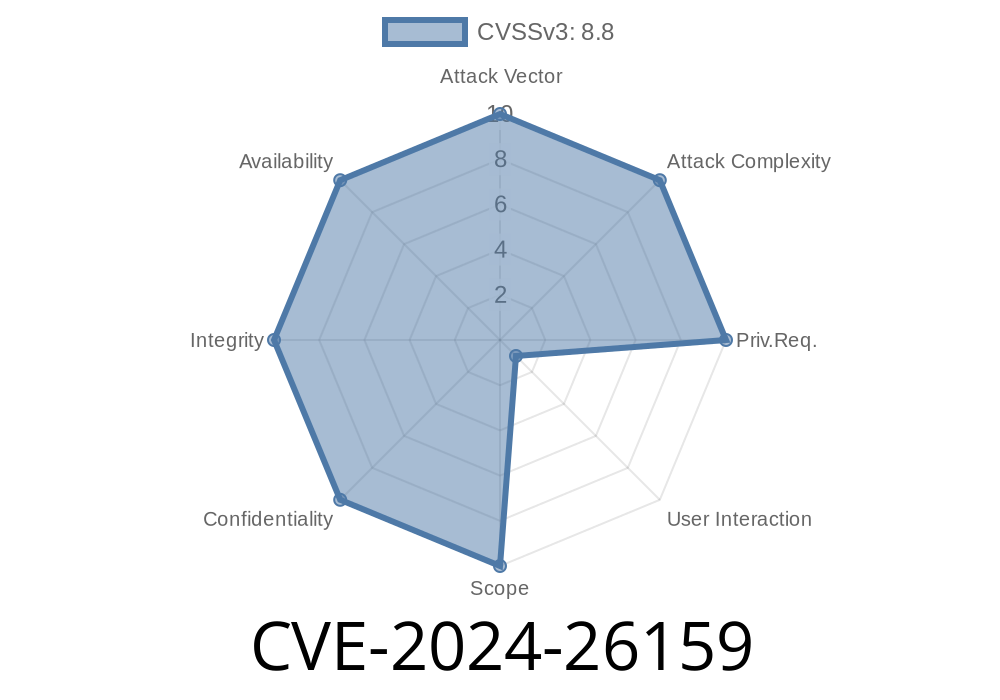A recently discovered vulnerability, CVE-2024-26159, has revealed a critical flaw in Microsoft's Open Database Connectivity (ODBC) driver, which allows a remote attacker to execute arbitrary code on affected systems. The severity of this vulnerability cannot be overstated, as it presents a significant risk to many enterprises using Microsoft's ODBC driver for database connectivity.
This article aims to explain the nature of the vulnerability, discuss available exploit details, and provide code snippets to illustrate the potential outcomes of a successful breach. We'll also link to the original references for further reading and provide guidance on mitigation and next steps.
Understanding CVE-2024-26159
To understand this vulnerability, it is crucial to know the role that the ODBC driver plays in a system. ODBC is a widely-used interface by applications to access diverse databases, providing a common language for communication between them. The Microsoft ODBC driver specifically enables communication between applications and SQL Server databases.
The vulnerability - CVE-2024-26159 - was introduced due to improper handling of certain data types in the ODBC driver's code, which could be exploited by a remote attacker to execute arbitrary code. An attacker with access to an affected system could craft a malicious SQL query that would exploit this flaw, allowing them to run unauthorized code at the system level.
Exploit Details
While a detailed exploit code hasn't been publicly disclosed yet, references to the vulnerability can help dissect the possible steps an attacker might take in abusing this flaw. According to the Common Vulnerabilities and Exposures (CVE) database:
"An attacker who successfully exploited this vulnerability could execute code in the context of the SQL Server Database Engine service account."
A hypothetical exploit scenario, leveraging this vulnerability, might look as follows
1. The attacker gains access to an affected system (perhaps through phishing, social engineering, or other means).
The improper handling of data types in the ODBC driver code leads to arbitrary code execution.
6. With elevated privileges, the attacker now has control over the system, which can be used to perform further malicious activities.
Code Snippet
As mentioned earlier, a specific exploit code isn't public yet. However, the following SQL code snippet offers insight into how a crafted SQL query might look:
-- Hypothetical SQL query exploiting CVE-2024-26159
DECLARE @maliciousCode NVARCHAR(MAX);
SET @maliciousCode = N'
-- Arbitrary malicious code here
';
-- Exploit the vulnerability to execute the code above
EXEC sp_executesql @maliciousCode;
This code snippet, although hypothetical, demonstrates that a seemingly innocuous SQL query can cause significant damage when exploiting a vulnerability like CVE-2024-26159.
For more information on this vulnerability, please refer to the following sources
- CVE Entry: CVE-2024-26159
Mitigation and Next Steps
To protect systems from this vulnerability, the best course of action is to apply the latest security updates and patches provided by Microsoft. Comprehensive patching and regular monitoring for security updates are essential practices to maintain a robust security posture.
Furthermore, organizations should limit access to their systems and networks to prevent unauthorized individuals from gaining access and attempting to exploit known or unknown vulnerabilities. Implementing network segmentation, strong authentication protocols, and user-awareness training can help minimize the risks associated with these types of threats.
Conclusion
CVE-2024-26159 is a critical vulnerability in Microsoft's ODBC driver that, if exploited, could allow a remote attacker to execute arbitrary code. This article aimed to provide details about the vulnerability and offered a hypothetical code snippet to give an understanding of the exploit process. Organizations should prioritize applying security updates and patches to mitigate the risks associated with this vulnerability.
Timeline
Published on: 03/12/2024 17:15:54 UTC
Last modified on: 03/12/2024 17:46:17 UTC
